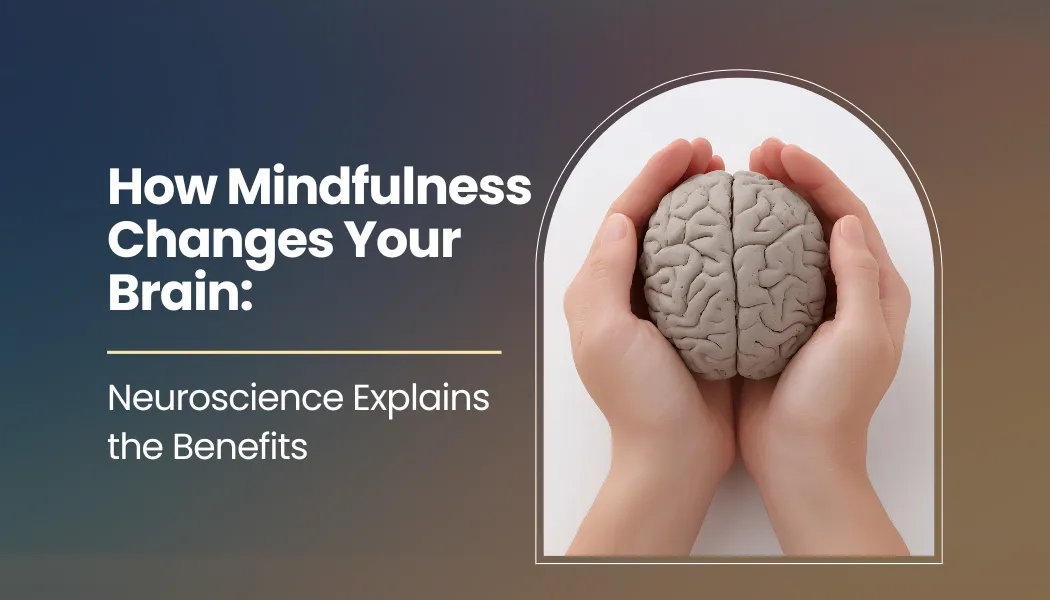Mindfulness has become one of the most widely practiced tools for reducing stress, improving focus, and enhancing overall well-being. From apps and online courses to corporate wellness programs and schools, mindfulness has found its place in modern life. But beyond the hype, what is actually happening in the brain when we practice mindfulness? Neuroscience offers fascinating insights, showing that mindfulness isn’t just a feel-good habit—it physically changes the structure and function of the brain, rewiring the way we think, feel, and respond to the world.
Understanding these brain changes not only explains why mindfulness is effective but also highlights the importance of consistent practice. It’s not about meditating for hours in one session; rather, it’s about small, deliberate, and regular engagement that trains the brain over time.
Table of contents
- The Science Behind Mindfulness
- Key Brain Areas Impacted by Mindfulness
- Mindfulness and Stress Reduction
- Neuroplasticity: Your Brain Can Change
- The Importance of Consistency
- Mindfulness and Emotional Intelligence
- Real-Life Examples
- Practical Tips to Train Your Brain
- Mindfulness Beyond Meditation
- The Bigger Picture: Why Mindfulness Works
- Final Thoughts
The Science Behind Mindfulness
At its core, mindfulness is the practice of paying attention—intentionally, without judgment, and in the present moment. It might sound simple, but the effects on the brain are profound. Neuroscientists use tools like fMRI (functional Magnetic Resonance Imaging), EEG (electroencephalography), and longitudinal studies to observe the brain’s response to mindfulness.
Studies consistently show that mindfulness affects areas involved in attention, emotional regulation, memory, and self-awareness. These changes are not fleeting. With regular practice, they lead to long-term improvements in cognition, emotional resilience, and even physical health.
For example, participants in an eight-week mindfulness program often show measurable changes in brain regions responsible for attention and emotion, highlighting the power of consistent, structured practice.
Key Brain Areas Impacted by Mindfulness
1. Prefrontal Cortex: Strengthening Focus and Decision-Making
The prefrontal cortex is often referred to as the brain’s executive center. It handles decision-making, attention, planning, and self-control. Research shows that mindfulness meditation increases activity and thickness in this region.
This strengthening leads to:
- Improved concentration and focus, even in distracting environments.
- Better decision-making, reducing impulsive or emotional reactions.
- Enhanced problem-solving skills and planning abilities.
A practical example: Imagine staying calm and focused during a tense work meeting rather than reacting emotionally. Mindfulness strengthens the prefrontal cortex, helping you navigate such situations more effectively.
2. Amygdala: Calming Emotional Reactivity
The amygdala is the brain’s emotional alarm system, particularly sensitive to fear, stress, and threat signals. Chronic stress or anxiety often leads to an overactive amygdala.
Mindfulness helps by:
- Reducing amygdala activity, which lowers stress and anxiety.
- Enhancing connections between the prefrontal cortex and amygdala, allowing for better emotional regulation.
People practicing mindfulness report feeling less reactive, experiencing more patience, and responding thoughtfully instead of impulsively. Over time, these changes can lead to lasting improvements in mental health.
3. Hippocampus: Enhancing Learning and Memory
The hippocampus is critical for memory, learning, and emotional regulation. Studies show that regular mindfulness practice increases gray matter density in the hippocampus.
The benefits include:
- Improved ability to remember and recall information.
- Greater capacity to manage emotions effectively.
- Enhanced resilience in challenging or stressful situations.
For students or professionals, this means mindfulness can enhance both learning and performance under pressure.
4. Default Mode Network: Quieting Overthinking
The default mode network (DMN) is a network of brain regions active when we are not focused on the outside world—when our mind wanders, ruminates, or dwells on the past or future. Overactivity in the DMN is linked to stress, anxiety, and depression.
Mindfulness quiets the DMN, leading to:
- Reduced rumination and worry.
- Increased presence and awareness.
- Better ability to focus on tasks without distraction.
By training the brain to stay present, mindfulness helps us engage more fully in life and improves overall mental clarity.
Mindfulness and Stress Reduction
One of the most widely recognized benefits of mindfulness is stress reduction. Neuroscience explains why this is more than a feeling—it’s biological.

- Cortisol reduction: Mindfulness lowers cortisol, the stress hormone that affects sleep, digestion, and overall health.
- Regulated nervous system: Mindfulness helps balance the sympathetic (fight-or-flight) and parasympathetic (rest-and-digest) systems, promoting calmness.
- Emotional resilience: Stronger prefrontal-amygdala connections mean we can handle stressful situations more effectively.
For example, a busy professional who regularly practices mindfulness may find that deadlines, meetings, and unexpected challenges no longer trigger overwhelming stress. The brain learns to respond calmly rather than react emotionally.
Neuroplasticity: Your Brain Can Change
A key concept behind the neuroscience of mindfulness is neuroplasticity—the brain’s remarkable ability to reorganize itself by forming new neural connections.
Through mindfulness:
- Attention and concentration improve as neural pathways in the prefrontal cortex strengthen.
- Emotional regulation improves as connections between the prefrontal cortex and amygdala become more robust.
- Self-awareness increases as the brain develops better integration across various networks.
This means mindfulness is not just a temporary fix; it literally reshapes the brain over time, making it more resilient, focused, and emotionally balanced.
The Importance of Consistency
Neuroscience shows that consistency matters more than session length. Short, daily mindfulness sessions—even 10–15 minutes—produce measurable changes in the brain. Sporadic long sessions are less effective because neuroplasticity relies on frequent reinforcement.
Think of it like physical exercise: the brain responds best to regular “workouts” rather than occasional marathons. Daily practice builds the mental and emotional muscles that mindfulness promises.
Mindfulness and Emotional Intelligence
Mindfulness also strengthens emotional intelligence, the ability to recognize, understand, and manage your own emotions and those of others. Neuroscience research shows:
- Greater self-awareness: Mindfulness helps you notice thoughts and feelings without being overwhelmed.
- Better empathy: Improved brain connectivity supports understanding and relating to others’ perspectives.
- Enhanced regulation: You learn to respond thoughtfully rather than react impulsively, improving relationships and communication.
For example, a parent practicing mindfulness may respond calmly when their child throws a tantrum, instead of reacting with frustration.
Real-Life Examples
Workplace Productivity
Employees who practice mindfulness report higher focus, better decision-making, and less burnout. Neuroscience suggests these benefits arise from stronger prefrontal cortex activity and quieter default mode networks.
Students and Learning
Mindfulness improves attention and working memory. Students who meditate regularly show better academic performance and reduced anxiety during exams.
Everyday Life
From mindful eating to walking or listening, integrating mindfulness into daily routines rewires the brain. Every small practice strengthens neural pathways, reinforcing presence and calm.
Practical Tips to Train Your Brain
Based on neuroscience, here’s how to get the most from mindfulness:
- Start small and stay consistent: Even 10 minutes daily is effective.
- Anchor attention: Focus on the breath, body sensations, or sounds around you.
- Observe without judgment: Let thoughts pass without reacting—this strengthens prefrontal control.
- Use mindfulness in daily life: Walking, eating, or even washing dishes can become mindful practices.
- Be patient: Brain changes take time, but persistence brings measurable benefits.
Mindfulness Beyond Meditation
While formal meditation is powerful, mindfulness extends far beyond it:
- At work: Enhances focus, creativity, and decision-making.
- In relationships: Promotes active listening and empathy.
- For health: Reduces stress, improves sleep, and strengthens the immune system.
Neuroscience confirms that integrating mindfulness into daily life maximizes brain and body benefits.
The Bigger Picture: Why Mindfulness Works
Mindfulness is more than a trend. Neuroscience shows it reshapes the brain, improves emotional resilience, and promotes health. It demonstrates that our brains are adaptable, and with consistent practice, we can cultivate focus, calm, and awareness.
It also reminds us that small, regular actions have enormous impact. Just as consistent exercise strengthens the body, consistent mindfulness strengthens the brain.
Whether you want to reduce stress, improve focus, or enhance emotional intelligence, mindfulness is a science-backed tool with transformative potential.
Final Thoughts
Neuroscience confirms what mindfulness practitioners have long experienced: it works. From strengthening attention and memory to calming the emotional brain and reducing stress, mindfulness is a powerful way to cultivate a healthier, more present mind.
By practicing consistently, even for a few minutes a day, you can reshape your brain, improve emotional well-being, and enhance daily life. The science is clear: mindfulness changes the brain—and through the brain, it changes the way we live.
